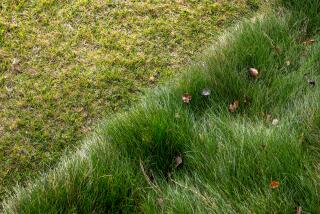Ways to lighten up on watering
- Share via
Style of turf. The first place to start is with the type of turf. Tall fescue is the most drought-tolerant of the main types of popular lawn grasses. Bahia, centipede or buffalo grasses also require less water.
Cut higher. Cutting the blades higher, to 3 or 4 inches tall, can shade the soil’s surface and reduce evaporation by 70% to 80%, according to Paul Tukey, author of “The Organic Lawn Care Manual.” He also recommends leaving lawn clippings right where they are to provide shade and moisture to the soil.
Compost. Use natural fertilizers. “You want to build up the water-
holding capacity of the soil with compost,” Tukey says. “Your soil should be full of microbial life, as alive as you are.”
Sprinklers. The key to not wasting lawn water is finding out what your sprinklers are up to. “You have to know how much water your sprinklers are using,” says “Lawn Care for Dummies” author Lance Walheim. “Do a sprinkler audit.”
Don’t overwater. Fix broken sprinkler heads. Get timers set to the best times of the day for watering (early morning, not in the peak afternoon heat).
Artificial turf. One of the surest solutions is to replace the living carpet with a synthetic one. Artificial turf companies such as Synlawn (www.synlawn.com) are thriving, with realistic surfaces light-years from the Astroturf of decades past.
Less lawn. Or simply try a smaller lawn. Skip grass and get a flat green carpet with yarrow, thyme or juniper. The combinations of dry landscapes employing low-water California natives and succulents are endless. For ideas on native plant gardens, how to care for them and how to dig up that turf with minimal trauma to you and your neighbors, call the Rancho Santa Ana Botanic Garden’s native plant hotline at (909) 624-0838.






